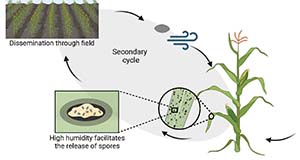Abstract
Tar spot, a fungal foliar disease, affects most maize types commonly grown in Florida, such as sweet corn, field corn, and criollo corn. This disease is characterized by brown-to-black, raised structures called stromata, which are embedded in leaf tissue. As a polycyclic disease, tar spot lesions can increase in number as the disease progresses throughout the growing season, leading to reduction of photosynthetic area on the leaves. Tar spot has recently emerged as a significant threat in Florida and in the United States, with reports of up to 100% incidence in maize fields in south Florida. Tar spot occurrence and development in Florida is influenced by several factors, such as environmental conditions, maize types, crop maintenance, and corn growth stages. The purpose of this publication is to promote awareness among Florida growers regarding this newly identified disease and its management practices.
References
Bajet, N. B., B. L. Renfro, and J. M. V. Carrasco. 1994. “Control of Tar Spot of Maize and Its Effect on Yield.” International Journal of Pest Management 40 (2): 121–125. https://doi.org/10.1080/09670879409371868
Caldwell, D. L., C. R. Da Silva, A. McCoy, H. Avila, J. C. Bonkowski, M. I. Chilvers, M. Helm, et al. 2023. “Uncovering the Infection Strategy of Phyllachora maydis during Maize Colonization: A Comprehensive Analysis.” Phytopathology® 114 (5). https://doi.org/10.1094/PHYTO-08-23-0298-KC
Corn IPM Pipe. n.d. “Tar Spot.” Assessed September 18, 2024. https://corn.ipmpipe.org/tarspot/
Dittrich, U., J. Hock, J. Kranz, and B. L. Renfro. 1991. “Germination of Phyllachora Maydis Ascospores and Conidia of Monographella Maydis.” Cryptogamic Botany 2 (2–3): 214–18.
Hock, J., J. Kranz, and B. L. Renfro. 1995. “Studies on the Epidemiology of the Tar Spot Disease Complex of Maize in Mexico.” Plant Pathology 44 (3): 490–502. https://doi.org/10.1111/J.1365-3059.1995.TB01671.X
Kleczewski, N. M., J. Donnelly, and R. Higgins. 2019. “Phyllachora maydis, causal agent of tar spot on corn, can overwinter in Northern Illinois.” Plant Health Progress 20 (3): 178–178. https://doi.org/10.1094/php-04-19-0030-br
McCoy, A. G., M. K. Romberg, E. R. Zaworski, A. E. Robertson, A. Phibbs, B. D. Hudelson, D. L. Smith, et al. 2018. “First Report of Tar Spot on Corn (Zea Mays) Caused by Phyllachora Maydis in Florida, Iowa, Michigan, and Wisconsin.” Plant Disease 102 (9): 1851. https://doi.org/10.1094/pdis-02-18-0271-pdn
Moura, V. S. M., L. C. Ferreira, M. Resende, and K. V. Xavier. 2023a. “Developing a Fungicide-based Program to Control Tar Spot on Sweet Corn in Florida.” (Abstr.) Phytopathology 113 (11S): S3.1–S3.197. https://doi.org/10.1094/PHYTO-113-11-S3.1
Moura, V. S. M., L. C. Ferreira, M. Resende, and K. V. Xavier. 2023b. “The History of Tar Spot on Maize in South Florida: A Continuous Survey.” (Abstr.) Phytopathology 113 (11S): S3.1–S3.197. https://doi.org/10.1094/PHYTO-113-11-S3.1
Mueller, D., K. Wise, A. Sisson, E. Sikora, T., R. Meyer, A. Koehler, et al. 2023. “Corn Disease Loss Estimates from the United States and Ontario, Canada — 2022.” Crop Protection Network. https://doi.org/10.31274/CPN-20230207-0
Peeling, J. A., J. Judge, V. Misra, C. B. Jayasankar, and W. R. Lusher. 2023. “Gap-Free 16-Year (2005–2020) Sub-Diurnal Surface Meteorological Observations across Florida.” Scientific Data 2023 10: 907. https://doi.org/10.1038/s41597-023-02826-4
Ross, T. J., M. I. Chilvers, A. M. Byrne, D. L. Smith, B. Mueller, S. Shim, and D. E. P. Telenko. 2023. “Effects of Disease Resistance and Fungicide Application on Management of Tar Spot on Corn in the North Central United States.” Plant Health Progress 24 (4): 439–444. https://doi.org/10.1094/PHP-10-22-0103-RS
Ruhl, G., M. K. Romberg, S. Bissonnette, D. Plewa, T. Creswell, and K. A. Wise. 2016. “First Report of Tar Spot on Corn Caused by Phyllachora Maydis in the United States.” Plant Disease 100 (7): 1496. https://doi.org/10.1094/pdis-12-15-1506-pdn
Solórzano, J. E., C. D. Cruz, B. E. Arenz, D. K. Malvick, and N. M. Kleczewski. 2023. “Tar Spot of Corn: A Diagnostic and Methods Guide.” Plant Health Progress 24 (1): 117–122. https://doi.org/10.1094/PHP-04-22-0033-DG
Telenko, D. E. P., M. I. Chilvers, A. M. Byrne, J. C. Check, C. R. Da Silva, N. M. Kleczewski, E. E. Roggenkamp, T. J. Ross, and D. L. Smith. 2022. “Fungicide Efficacy on Tar Spot and Yield of Corn in the Midwestern United States.” Plant Health Progress 23 (3): 281–287. https://doi.org/10.1094/PHP-10-21-0125-RS
USDA-NASS. 2023. “Quick Stats.” Accessed January 15, 2024. https://quickstats.nass.usda.gov/results/8AB68D99-BADE-386A-B773-1B6A765E2366
USDA-NASS. 2024. “Quick Stats.” Accessed January 15, 2024. https://quickstats.nass.usda.gov/results/55EEFC66-CD3C-3D1E-9A9D-67BC61D50562
Webster, R. W., C. Nicolli, T. W. Allen, M. D. Bish, K. Bissonnette, J. C. Check, M. I. Chilvers, et al. 2023. “Uncovering the Environmental Conditions Required for Phyllachora maydis Infection and Tar Spot Development on Corn in the United States for Use as Predictive Models for Future Epidemics.” Scientific Reports 2023 13: 17064. https://doi.org/10.1038/s41598-023-44338-6
Wright, D., I. Small, C. Mackowiak, Z. Grabau, P. Devkota, and S. Paula-Moraes. 2022. Field Corn Production Guide. EDIS 2022 (4). https://doi.org/10.32473/edis-ag202-2022

This work is licensed under a Creative Commons Attribution-NonCommercial-NoDerivatives 4.0 International License.
Copyright (c) 2024 UF/IFAS

